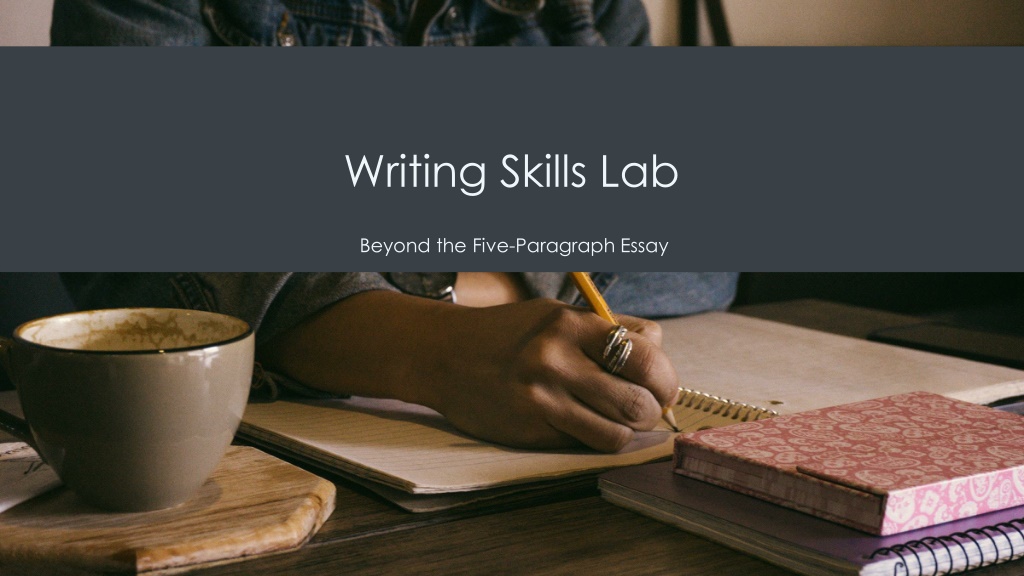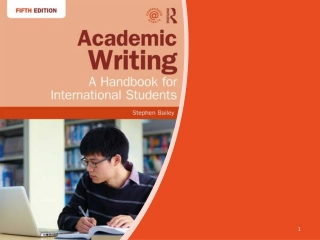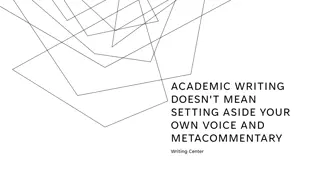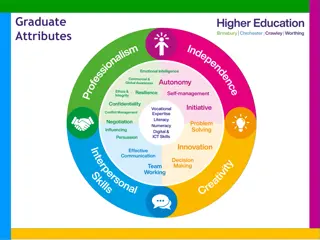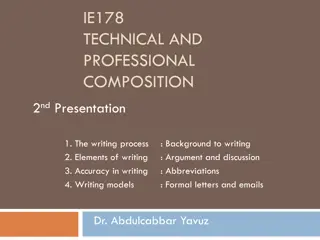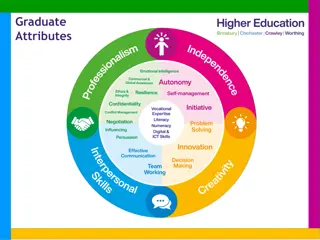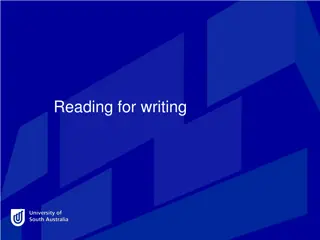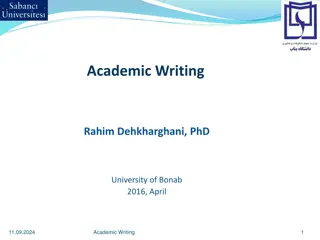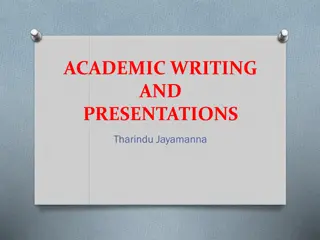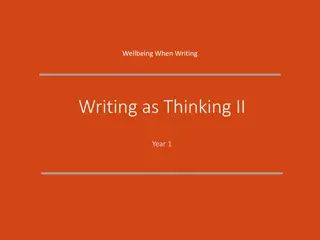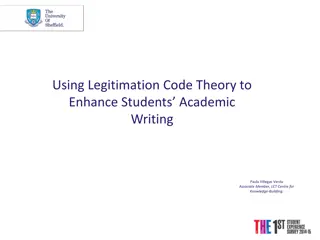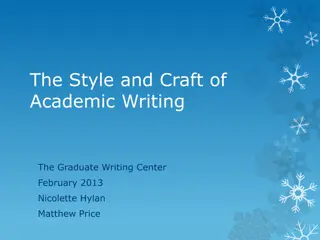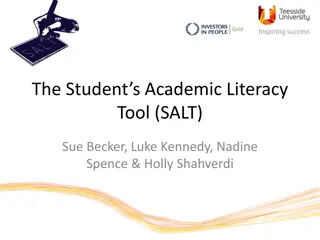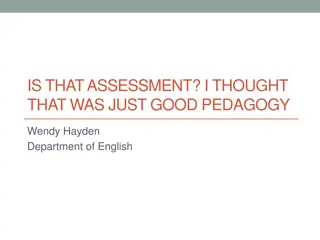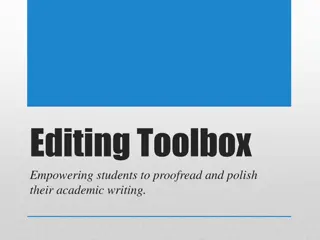Enhancing Academic Writing Skills Beyond Traditional Structures
Transitioning from high school to college writing involves moving beyond the restrictive five-paragraph essay format. College professors expect original, deep, and insightful arguments from independent junior scholars. A scholarly approach in college writing includes drafting, revising, and engaging in academic conversations with a unique perspective. Recognizing the difference between formulaic and organic essay structures is crucial for developing effective writing skills.
Download Presentation

Please find below an Image/Link to download the presentation.
The content on the website is provided AS IS for your information and personal use only. It may not be sold, licensed, or shared on other websites without obtaining consent from the author. Download presentation by click this link. If you encounter any issues during the download, it is possible that the publisher has removed the file from their server.
E N D
Presentation Transcript
Writing Skills Lab Beyond the Five-Paragraph Essay
Learning Outcomes: Beyond the Five-Paragraph Essay Recognize and evaluate strategies for moving beyond the five-paragraph essay Recognize and evaluate effective paragraphs Identify successful strategies for writing effective introductions and conclusions
Recognize and evaluate strategies for moving beyond the five-paragraph essay
Going Beyond the Five-Paragraph Essay College writing is different from high school writing. College professors view you as independent junior scholars and imagine you writing with a genuine, driving interest in tackling a complex question. They envision you approaching an assignment without a pre-existing thesis. They expect you to look deep into the evidence, consider several alternative explanations, and work out an original, insightful argument that you actually care about.
A Scholarly Approach Usually Entails writing a rough draft working out an ambitious thesis and the scope of your argument starting over with a wholly rewritten second draft containing a more complete argument anchored by a refined thesis acknowledging and addressing important implications further reading and research, more revision, and more drafting Writing a paper isn t about getting the right answer and adhering to basic conventions; it s about joining an academic conversation with something original to say, borne of rigorous thought.
Activity: Recognize Characteristics of Organically Structured Essays High school writing often emphasizes formulaic structure, such as the five- paragraph theme or the three-point essay. Those structures are appropriate as an introduction to academic writing because they teach writers to make a point and use evidence to support it in an organized way. Those structures are especially useful when responding to standardized tests under time pressure. You ll need to move beyond formulaic structures and learn how to develop and organize your ideas more organically. So, what s the difference between formulaic and organic structure?
Differentiate between formulaic and organic structure The skills involved in a very basic kind of essay often called the five- paragraph theme are indispensable. If you re good at the five-paragraph theme, then you re good at identifying a clear and consistent thesis, arranging cohesive paragraphs, organizing evidence for key points, and situating an argument within a broader context through the introduction and conclusion. Your college professors are looking for a more ambitious and arguable thesis, a nuanced and compelling argument, and real-life evidence for all key points, all in an organically structured paper.
Practice Questions What did you learn about the five-paragraph essay in your classes in the past? When is this structure useful? What are the benefits of this structure? What are the limits of this structure?
Organic Structure The first key difference is the thesis. Rather than simply positing a number of reasons to think that something is true, it puts forward an arguable statement: one with which a reasonable person might disagree. An arguable thesis gives the paper purpose. In the more organic structure each paragraph specifically leads to the next. The last key difference is seen in the conclusion. Because the organic essay is driven by an ambitious, non-obvious argument, the reader comes to the concluding section thinking, OK, I m convinced by the argument. What do you, author, make of it? Why does it matter?
Beyond Formulaic Understanding that college writing will demand more than a five-paragraph essay is the first step. But then what? How do writers move beyond the formulas that are so familiar and well practiced and begin to develop organic writing? A good starting place is to recharacterize writing as thinking. Throughout the process, the thesis serves as an anchor point while the author wades through the morass of facts and ideas. The writer continues to read to learn more about his or her issue and refines his or her ideas in response to what is learned. The dialogue between thesis and body continues until the author is satisfied or the due date arrives, whatever comes first.
Effective Paragraphs Effective paragraphs are the fundamental units of academic writing; consequently, the thoughtful, multifaceted arguments that your professors expect depend on them. Without good paragraphs, you simply cannot clearly convey sequential points and their relationships to one another.
Recognize techniques for effective paragraph construction In academic writing, readers expect each paragraph to have a sentence or two that captures its main point. These sentences are sometimes called topic sentences or key sentences. They establish the main point that the rest of the paragraph supports. They situate each paragraph within the sequence of the argument, a task that requires transitioning from the prior paragraph.
Logic in Paragraphs When you sit down to write, you don t usually tell yourself, I am going to write eight paragraphs that are four sentences long each. Effective and mature writing is more organic. Applying logic and structure to paragraphs comes in the revision stage. When you have completed a draft, one way to tackle organization and coherence in your revision is to study the logic and construction of individual paragraphs. There are four ways to classify these systems of logic and structure: Rank Order Spatial Chronological General to Specific
In-class Activity: Paragraphs and Transitions A very rough guide is that you need more than one or two paragraphs per page of type. Paragraphing conventions online require even shorter paragraphs, with multiple short paragraphs on one screen. Transitions are words or phrases that indicate linkages in ideas. When writing, you need to lead your readers from one idea to the next, showing how those ideas are logically linked. Activity: List transition words and phrases that help you keep your paragraphs and groups of paragraphs logically connected for a reader. Write as many as you can remember before you return back to the text.
Evaluate Paragraph Construction Fixing the logic and organization of paragraphs is an important part of the revision stage of the writing process. Since paragraph structure essentially punctuates an essay or other piece of writing, if your paragraphs do not make sense, or don t fit together in a way that makes sense, your reader will have a hard time following your message. There s no right or wrong way to revise a paragraph for logic. The sections you just read about topic sentences, logical organization methods, and transitions provide a good roadmap, but there is no formula for fixing paragraphs.
Identify successful strategies for writing effective introductions and conclusions
Introductions Provide background about a topic Locate readers in a specific time and/or place Start with a compelling quotation or statistic something concrete Include an ethical appeal, with which you (explicitly or implicitly) show that you ve researched your topic and are credible Articulate a main claim/thesis (but normally after some buildup) Lay out the stakes for the piece of writing that is, why the reader should bother reading on
Conclusions Summarize the argument in fresh language (especially in longer pieces of writing) Bookend a story or idea that started in the introduction Include an emotional appeal, with which you (explicitly or implicitly) connect the logic of the argument to a more passionate reason intended to sway the reader Issue a call to action Make some sort of prediction or assessment about the future of your topic or future research that needs to be done on the topic
Quick Review College writers: compose nuanced, original theses that are discovered, clarified, and refined throughout the writing process allow the content of their writing to determine the structure. use an organic process that is recursive and emphasizes revision. use key sentences to establish a paragraph s main point and situate the paragraph within the sequence of the argument. apply logic and structure to paragraphs in the revision stages. build introductions and conclusions recursively throughout the writing process. use introductions to orient their readers to the topic and conclusions to provide fresh perspectives.
